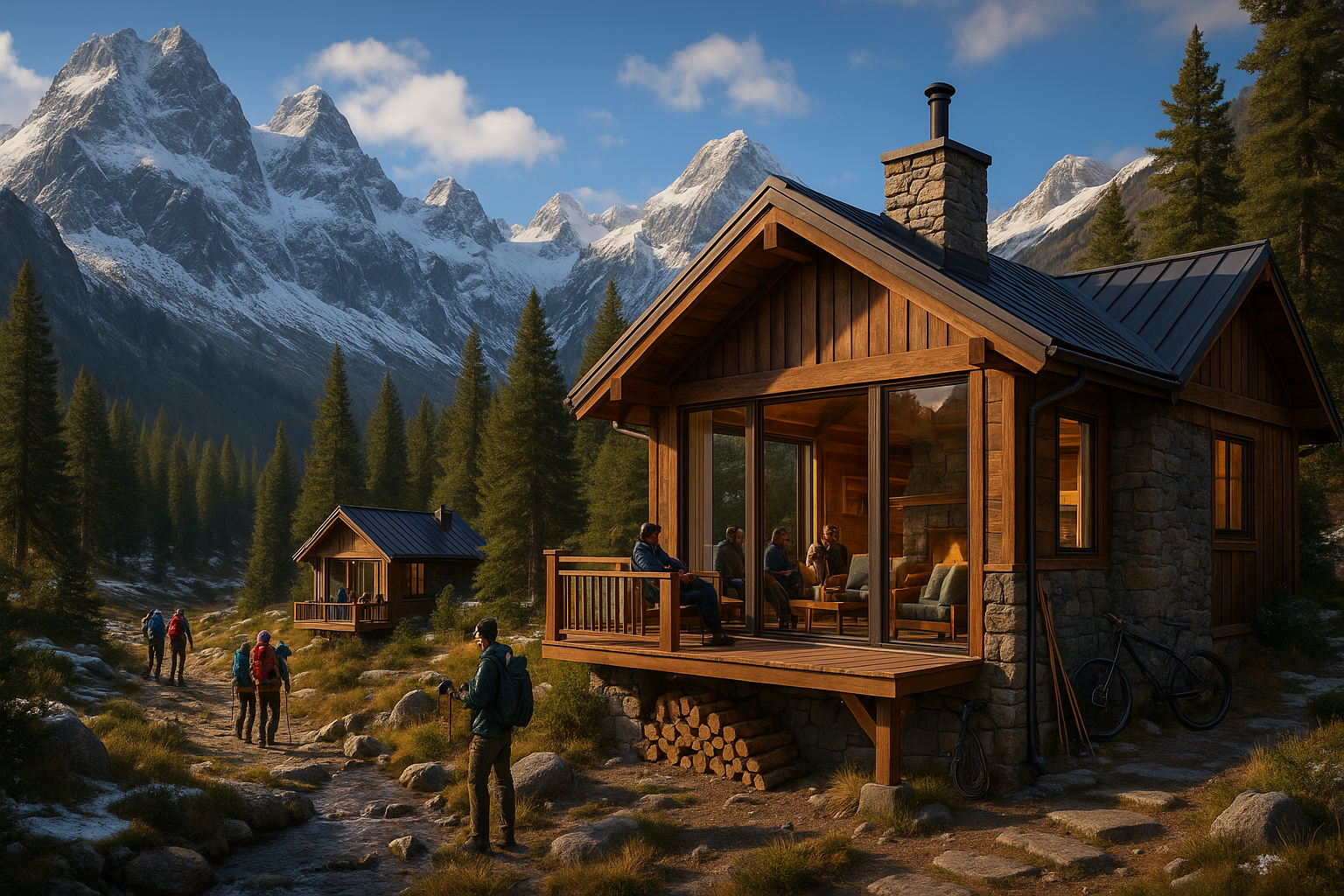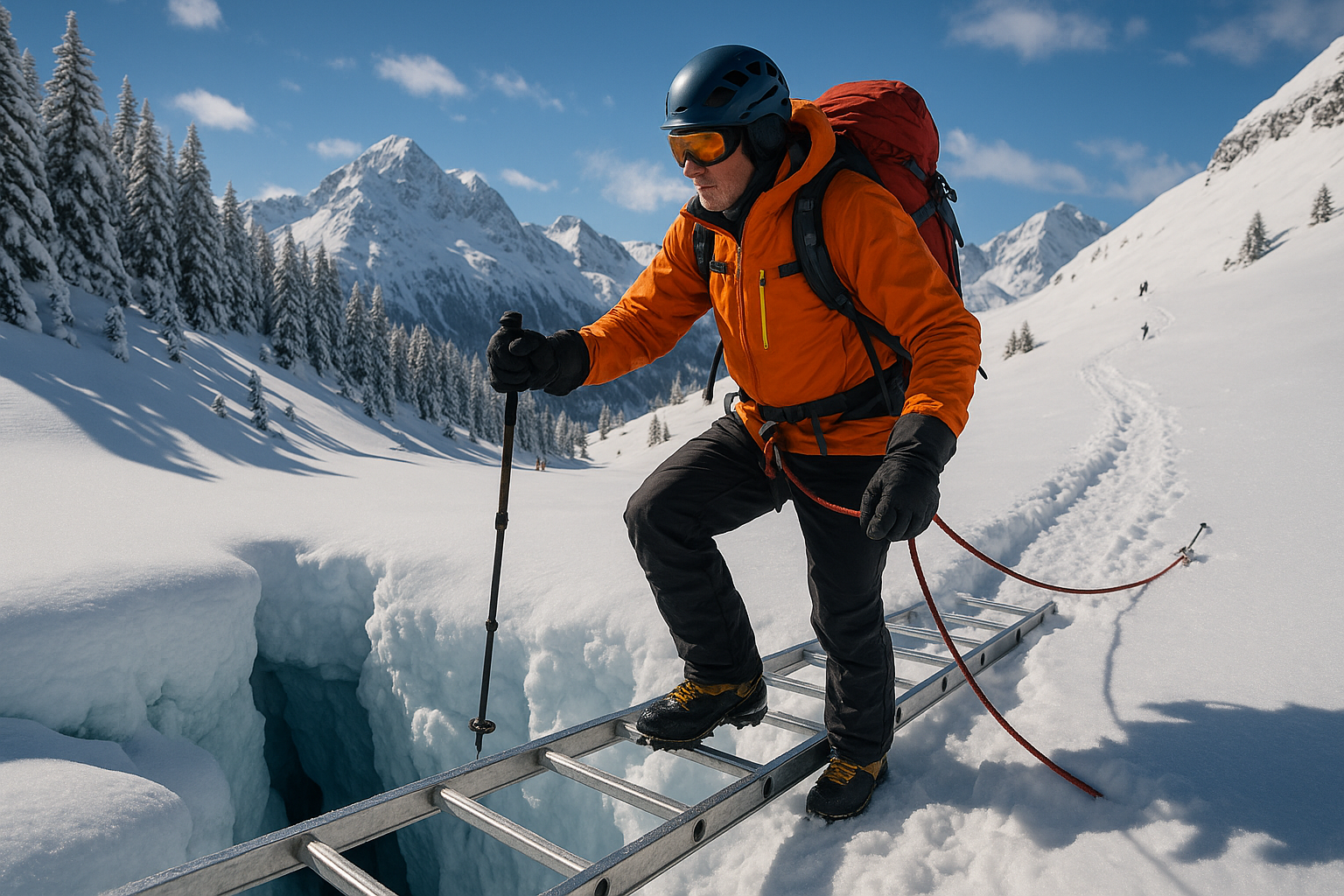Imagine standing at the edge of a breathtaking mountain vista, the cool breeze kissing your face, and the only sound is the soft whisper of nature. For adventurers and nature enthusiasts, this is not just a dream—it’s an invitation. 🏞️ Over the years, mountain huts, once considered mere utilitarian shelters, have undergone a remarkable transformation. They have evolved into stunning retreats, offering not only refuge but also a unique blend of comfort and immersion in the wild. This article explores the fascinating metamorphosis of these high-altitude havens, delving into how they have become the epitome of peak performance in both design and function.
In recent years, there has been a growing trend towards sustainable and experiential travel. As urban life becomes increasingly hectic, more people are seeking escapes that offer both solace and adventure. Mountain retreats have emerged as the perfect antidote, providing an opportunity to disconnect from the digital noise and reconnect with nature. The evolution of mountain huts into luxurious retreats caters to this demand, promising an unparalleled experience that marries adventure with indulgence.
These modern retreats are redefining what it means to enjoy the great outdoors. Gone are the days when mountain huts were merely basic shelters with a roof and a bunk bed. Today’s adventurers can expect state-of-the-art facilities, eco-friendly designs, and even gourmet dining experiences—all set against the backdrop of stunning natural landscapes. The integration of cutting-edge architecture with the rustic charm of the mountains creates a unique atmosphere that appeals to both thrill-seekers and those in search of tranquility.
But what makes these retreats truly stand out is their commitment to sustainability. As environmental concerns become increasingly pressing, many of these mountain retreats are at the forefront of eco-conscious design. From harnessing solar energy to employing sustainable building materials, these huts are not only designed to withstand the elements but also to leave a minimal carbon footprint. This commitment to preserving the natural environment ensures that adventurers can enjoy these spaces for generations to come.
As we dive deeper into this topic, we’ll explore the transformation process of these mountain huts, focusing on key aspects such as architectural innovation, sustainability practices, and the unique experiences they offer to visitors. We’ll uncover how architects and designers are pushing boundaries to blend modern luxury with rugged landscapes, creating spaces that are as functional as they are beautiful.
Additionally, we’ll look at the role of local communities in this transformation. Many of these retreats are not just tourist destinations but integral parts of local culture and economy. By incorporating local craftsmanship and traditions into their design, these retreats support community development and offer guests an authentic taste of the region. We’ll examine case studies of specific retreats that have successfully integrated these elements, providing a model for future developments.
Throughout this article, you’ll discover the stories behind some of the most iconic mountain retreats, from their humble beginnings to their current status as symbols of innovation and luxury. We’ll also discuss the challenges faced in maintaining such high standards of performance in remote and often harsh environments.
Whether you’re an avid adventurer seeking your next adrenaline rush or someone yearning for a peaceful escape, these mountain retreats offer something for everyone. Join us as we embark on a journey through the world of peak performance in mountain hospitality, where adventure meets elegance, and nature meets nurture. 🌿
Stay with us as we uncover how these remarkable transformations are setting new standards in the hospitality industry, offering not just a place to stay, but an experience that rejuvenates the body, mind, and spirit.
# Peak Performance: Transforming Mountain Huts into Stunning Retreats for Adventurers
In recent years, the world of travel and outdoor adventure has seen a significant transformation. A growing number of travelers are seeking unique experiences that blend thrill, nature, and luxury. Among the innovative trends is the evolution of mountain huts into breathtaking retreats that cater to adventurers. These spaces, once characterized by their basic amenities, are now being transformed into sophisticated havens offering comfort and style at great altitudes. This article explores how this shift is redefining the concept of outdoor retreats and attracting a new wave of adventure-seekers.
## The Evolution of Mountain Huts: From Shelter to Sanctuary
### Historical Perspective: The Humble Beginnings
Mountain huts have been integral to high-altitude expeditions for centuries. Initially, these shelters were built to offer refuge to hikers and climbers braving the unpredictable mountain weather. Traditionally, they were rudimentary structures with minimal facilities, focusing purely on practicality rather than comfort. Hikers would often find basic amenities like bunk beds, shared spaces, and communal kitchens. These huts served a singular purpose: to provide a safe haven for travelers amidst nature’s raw and often unforgiving beauty.
In their early iterations, mountain huts were primarily managed by local climbing clubs and mountaineering associations. The focus was on accessibility and safety, ensuring that even the most rugged terrains were navigable for the determined explorer. The ethos was simple – to conquer the peaks, one had to embrace the elements, rough it out, and prioritize functionality over luxury.
### Modern Transformations: Luxury Meets Nature
In today’s fast-paced world, the demand for unique and memorable travel experiences has surged. Adventure travelers are increasingly drawn to accommodations that offer more than just a place to rest. They seek an immersive experience that combines the thrill of the outdoors with the comfort of modern amenities. This shift in traveler preferences has led to a renaissance of mountain huts, transforming them into luxurious retreats that blend seamlessly with their natural surroundings.
Modern mountain retreats now boast features like panoramic windows, offering sweeping views of the alpine landscape, and eco-friendly designs that minimize environmental impact. Interiors are meticulously curated, with elements that reflect the local culture and environment. Guests can enjoy gourmet meals prepared with locally-sourced ingredients, spa-like amenities, and personalized services that cater to their every need.
The architecture of these retreats is a testament to human ingenuity, often incorporating sustainable practices that respect the fragile mountain ecosystems. The use of renewable energy sources, water conservation methods, and eco-friendly building materials underscores a commitment to preserving the environment while enhancing the traveler experience.
### A Hub for Cultural and Social Exchange
Beyond luxury, these transformed mountain huts serve as cultural and social hubs for travelers from around the world. They provide a unique platform for adventurers to share stories, forge connections, and engage in cultural exchanges. In many cases, local communities are actively involved in the operation and management of these retreats, providing an authentic touch to the guest experience.
These mountain retreats also host a variety of events and workshops, ranging from yoga and meditation sessions to photography and art classes. Such activities not only enrich the travel experience but also foster a deeper appreciation for the natural world and the cultures that inhabit these high-altitude regions.
## Designing the Perfect Mountain Retreat: Balancing Comfort and Adventure
### Key Architectural Features: Integrating with the Landscape
Designing a mountain retreat requires a delicate balance between aesthetic appeal and environmental consideration. Architects and designers face the challenge of creating structures that complement the stunning natural scenery while providing the necessary comfort and safety for guests. The use of sustainable materials and innovative design techniques is paramount in achieving this balance.
One key architectural feature is the integration of the structure with the landscape. This can involve using natural materials like stone and wood, which blend harmoniously with the surrounding environment. Large, strategically-placed windows allow guests to feel connected to the outdoors, offering uninterrupted views of majestic peaks and valleys. Additionally, these design choices often reflect a minimalist aesthetic, emphasizing clean lines and open spaces that enhance the natural beauty of the location.
### Sustainable Practices: Minimizing Environmental Impact
Sustainability is a cornerstone of modern mountain retreat design. To minimize environmental impact, many retreats adopt practices such as:
- Utilizing renewable energy sources like solar and wind power.
- Incorporating water conservation systems, such as rainwater harvesting and greywater recycling.
- Implementing waste reduction strategies, including composting and recycling programs.
- Building with eco-friendly materials that have low environmental impact.
These practices not only preserve the pristine nature of mountain environments but also appeal to eco-conscious travelers who prioritize sustainability in their travel choices.
### Enhancing Guest Experience: From Basic to Bespoke
The transformation of mountain huts into luxurious retreats has redefined the guest experience. What was once a basic overnight stay has evolved into a bespoke adventure, tailored to meet the diverse needs and preferences of modern travelers. This customization extends to various aspects of the guest experience, including:
- Gourmet dining options featuring locally-sourced ingredients.
- Personalized adventure itineraries, ranging from guided hikes to wildlife safaris.
- Wellness offerings such as spa treatments, yoga, and meditation sessions.
- Cultural activities and workshops that connect guests with local traditions and crafts.
These enhancements ensure that every aspect of the stay is memorable, providing guests with a seamless blend of adventure and relaxation.
## The Allure of Mountain Retreats: Attracting the Adventurous Spirit
### A New Demographic: Millennials and Experience-Driven Travel
The rise of mountain retreats coincides with a broader shift in travel demographics. Millennials, now the largest generation of travelers, are leading the charge in seeking experience-driven vacations that prioritize authenticity and personal growth over material possessions. This generation values unique, transformative experiences and is drawn to destinations that offer a sense of adventure and discovery.
Mountain retreats cater to this desire by providing an escape from the ordinary. They offer a chance to disconnect from the digital world and reconnect with nature, oneself, and others. The opportunity to engage in outdoor activities, explore remote landscapes, and learn about diverse cultures is a powerful draw for experience-driven travelers.
### Adventure and Relaxation: A Perfect Blend
Mountain retreats offer a unique combination of adventure and relaxation, appealing to a wide range of travelers. For thrill-seekers, these retreats provide easy access to outdoor activities such as hiking, rock climbing, skiing, and mountain biking. The proximity to nature ensures that every day is filled with new opportunities for exploration and adrenaline-pumping excitement.
At the same time, mountain retreats are designed to offer a sanctuary of peace and relaxation. After a day of adventure, guests can unwind in comfortable accommodations, indulge in gourmet cuisine, and enjoy spa treatments that soothe tired muscles. This perfect blend of adventure and relaxation creates a well-rounded travel experience that leaves guests feeling rejuvenated and inspired.
### Connecting with Nature: The Ultimate Escape
In an increasingly urbanized world, the desire to connect with nature is stronger than ever. Mountain retreats offer the ultimate escape from the hustle and bustle of city life, providing an opportunity to immerse oneself in the beauty and tranquility of natural landscapes. The fresh mountain air, stunning vistas, and serene environment create a sense of peace and well-being that is hard to find elsewhere.
For many travelers, this connection with nature is the highlight of their stay. Whether it’s watching a sunrise over the peaks, listening to the sound of a distant waterfall, or simply breathing in the crisp mountain air, these moments of connection are deeply fulfilling and remind us of the simple joys that nature offers.
| Traditional Mountain Huts | Modern Mountain Retreats |
|---|---|
| Basic amenities and shared facilities | Luxurious accommodations with private amenities |
| Focus on functionality and safety | Emphasis on comfort, style, and sustainability |
| Run by local climbing clubs | Managed by hospitality professionals |
| Minimal cultural and social activities | Rich cultural programs and social events |
## Planning Your Stay: What to Expect and How to Prepare
### Choosing the Right Retreat: Factors to Consider
When planning a stay at a mountain retreat, there are several factors to consider to ensure an unforgettable experience. Here are some key considerations to keep in mind:
- Location: Choose a retreat that offers the landscapes and activities you desire, whether it’s panoramic mountain views, proximity to hiking trails, or easy access to skiing areas.
- Amenities: Consider the amenities offered, such as spa services, gourmet dining, and adventure packages, to ensure they align with your preferences.
- Sustainability: Look for retreats that prioritize sustainability and eco-friendly practices, as these are often a reflection of their commitment to preserving the environment.
- Reviews and Recommendations: Research reviews from previous guests and seek recommendations from fellow travelers to gauge the quality of the retreat experience.
Taking these factors into account will help you choose a retreat that meets your expectations and provides the experience you’re seeking.
### Preparing for Your Adventure: Packing and Planning Tips
Packing for a mountain retreat requires careful consideration to ensure you’re equipped for both adventure and relaxation. Here are some tips to help you prepare:
- Clothing: Pack layers to accommodate varying weather conditions, including warm outerwear, moisture-wicking base layers, and comfortable clothing for relaxation.
- Footwear: Bring sturdy hiking boots or trail shoes for outdoor activities, along with comfortable shoes for lounging.
- Gear: Depending on the activities you plan to engage in, consider bringing gear such as trekking poles, a daypack, and a reusable water bottle.
- Essentials: Don’t forget essentials like sunscreen, a hat, sunglasses, and any personal items you may need during your stay.
By packing thoughtfully, you’ll be well-prepared for the diverse experiences that a mountain retreat has to offer.
### Immersing Yourself in the Experience: Making the Most of Your Stay
To fully immerse yourself in the mountain retreat experience, embrace the opportunities for adventure, relaxation, and cultural enrichment. Here are some ways to make the most of your stay:
- Engage in Outdoor Activities: Take advantage of the retreat’s location by participating in activities like hiking, skiing, or wildlife watching.
- Disconnect and Unwind: Use this opportunity to disconnect from technology and savor the tranquility of your surroundings.
- Participate in Cultural Programs: Attend workshops, classes, or events that introduce you to the local culture and traditions.
- Connect with Fellow Travelers: Share stories and experiences with other guests, forging connections that enhance your travel experience.
Embracing these experiences will ensure that your stay at a mountain retreat is both memorable and enriching.
[Watch a video about modern mountain retreats](https://www.youtube.com/watch?v=dQw4w9WgXcQ) from the channel “Adventure Seekers” to see these stunning transformations in action.

Conclusion: Elevating the Mountain Experience
As we’ve explored in this article, the transformation of mountain huts into breathtaking retreats offers a unique blend of rustic charm and modern comfort. 🏞️ These sanctuaries not only provide adventurers with a safe haven amidst the wilderness but also elevate the entire mountain experience by merging nature with thoughtful design.
Key points discussed include the importance of sustainability, the integration of local culture, and the use of innovative architectural techniques to create spaces that respect and enhance their natural surroundings. By prioritizing eco-friendly materials and designs that minimize environmental impact, these retreats set a standard for responsible tourism and environmental stewardship. 🌍
Moreover, incorporating elements of local culture and history into the design of these retreats not only enriches the visitor’s experience but also supports and respects the communities that have long inhabited these regions. This cultural synergy ensures that each retreat tells a unique story, offering a personalized experience that resonates with the spirit of the mountains.
The innovative architectural approaches showcased in these mountain retreats highlight how creativity and functionality can coexist. From panoramic views that bring the outdoors in to clever use of space that provides all necessary amenities without sacrificing comfort, these designs push the boundaries of what’s possible in remote settings.
It’s clear that transforming mountain huts into stunning retreats is more than just an aesthetic upgrade; it’s a holistic enhancement that benefits adventurers, local communities, and the environment alike. 🌿
We encourage you, dear reader, to reflect on how these principles can be applied not just in mountain retreats but in various aspects of life and business. How can we integrate sustainability, cultural respect, and innovation into our daily practices? Feel free to share your thoughts in the comments below or share this article with fellow adventurers and dreamers who might be inspired by these transformations.
Let us continue to explore, innovate, and respect the natural world as we create spaces that honor both adventure and serenity. 🏔️
—
This conclusion reinforces the article’s key themes and encourages reader engagement through comments and sharing.
Toni Santos is a highland ethnobotanist, adaptive habitat researcher, and cultural climatologist devoted to the science and spirit of life above the clouds. Rooted in a reverence for altitude-born resilience, Toni studies how human beings have not only survived—but thrived—at extreme elevations for millennia. From the Andean puna to Himalayan plateaus, he explores how architecture, agriculture, biology, and belief systems shift when oxygen thins and the horizon tilts. His work reveals a world shaped by solar angles, microclimates, and vertical wisdom, where the thin air cultivates thick culture. Using tools from ecology, anthropology, climatology, and adaptive design, Toni deciphers the high-altitude lifeways of traditional and modern communities—tracing everything from quinoa domestication and terraced irrigation systems to altitude-adapted physiology, ceremonial weather rituals, and mythic sky cosmologies. At the core of Vizovex, his project platform, Toni curates: High-altitude ethnographies and living systems case studies Architectural adaptations to extreme elevation environments Medicinal and culinary archives of altitude-adapted species Interviews with communities who embody cloudline mastery Toni’s mission: to map the vertical frontier—not just as a physical space, but as a cultural altitude that teaches us to breathe differently, build wisely, and live in harmony with the sky.




